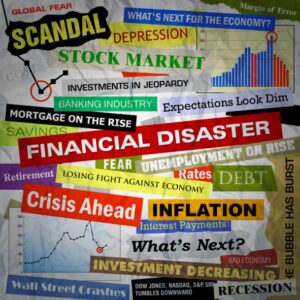
The first in a series of articles developed to define and personalize the Wealth That Lasts Process. This process is based on your personal values and goals, in balance with your assets and lifestyle needs. It is designed to block out the noise of the investment markets and allow you to focus on the things that are truly important in your life.
When I started in this industry more than 20 years ago I was very open to everything I could read or hear relating to investing and the investment markets. I especially remember the long drive to and from my office and the impact the market reports had on my sense of well-being. When the markets were positive it sounded like, “The Dow Jones Industrial average eked out a meager gain of 27 points today.” But when the markets were negative I heard, “Markets plunged 32 points today in fears that we are approaching the end of the world.”
It didn’t take long for me to realize that overly dramatic reporting was counter-productive so I became immune to the often sensational expert opinions. Unfortunately, over the years I have met with many investors who have fallen prey to the media, marketing firms, financial professionals and academics who attempt to create an environment filled with greed and fear. These professionals realize that you, as an individual investor, won’t seek new information if you are comfortable and happy; so new problems are identified or even created on a regular basis to keep you off balance and in search of support. Keeping you uncomfortable means you are more likely to buy newspapers and seek professional assistance.
 As an illustration, I carry two front-page, above the fold articles from prominent San Francisco newspapers in my briefcase. The first headline reads, “Panic Hammers the Market;” an article which details the carnage that occurred during a particularly bad day in late 1998. The second headline reads, “Stocks Bounce Back.” This article particulars a dramatic recovery from the previous day’s problems. The first headline was from a morning edition, and the second was from an afternoon edition. Within the span of a few hours, emotions ran the gamut from fear and panic to greed and a feeling of missed opportunity.
As an illustration, I carry two front-page, above the fold articles from prominent San Francisco newspapers in my briefcase. The first headline reads, “Panic Hammers the Market;” an article which details the carnage that occurred during a particularly bad day in late 1998. The second headline reads, “Stocks Bounce Back.” This article particulars a dramatic recovery from the previous day’s problems. The first headline was from a morning edition, and the second was from an afternoon edition. Within the span of a few hours, emotions ran the gamut from fear and panic to greed and a feeling of missed opportunity.
The natural fallout from a market cycle, such as the one we are currently experiencing, includes numerous commentaries delineating how obvious it was that the decline was about to happen. The commentators tell investors that if they had been properly informed, by them, they would not only have avoided the anxiety and loss of their money, but would have profited from the author’s insight. The true ‘insight’ to be gleaned from such articles is that the author hopes to guarantee himself a future audience (and their ensuing dollars) for his market projections. The only certainty is that there will constantly be events, positive and negative, in the investment markets and some of them will tear at our emotions. Along with that constant push and pull, there will be those making bold projections; every once in a while those bold projections will be correct and that ensures the cycle will continue. As my father says, “Even a broken clock is right twice a day.”
Information Overload
With the speed and volume of information increasing so rapidly, investors are constantly bombarded with information and opinions. There are a seemingly infinite number of articles dedicated to the subjects of how to pick stocks or mutual funds, time markets, and make major strategic shifts in portfolios. The Internet, magazines, newspapers, television, friends, relatives, barbers, bankers and brokers all try to provide “advice” on how money should be invested. However, if investors don’t know which information to ignore, then the only alternative is to react with undifferentiated attention to all of this NOISE. In effect, they will be going everywhere and nowhere in particular at the same time. I don’t want to stop the information, but I want to help investors establish a well thought out plan that helps them decide which small percentage of the information is useful to them. With that plan in place you can block out the noise and refocus your attention where it belongs: on your values and your goals in balance with your assets and lifestyle needs.
Planning
Regardless of profession, for most of us our wealth is our most important business, but most investors manage their investments and their families’ future in a non- businesslike manner. How many families have taken the time to establish a solid business plan? How many of the people offering “advice” to these families on their investment businesses know what it is that the families are trying to accomplish? I’ve been interviewing and advising families for over 20 years, and the number of families or advisors that manage wealth in a proactive, comprehensive, objective, easily communicated way is exceedingly few.
 This is somewhat surprising to me because when I ask a group of investors to list the elements of a well-run business I get answers such as a business plan, financing, a management team, a solid balance sheet, competent personnel, accounting, legal work, etc. These are great answers and seem easy for them to come up with. I then ask, “Should a business have these elements in place before they begin operating, or after operating the business for several months or even years?” The answer is obvious, they need to have these plans in place before they start, but most individual investors do not plan their venture until long after they have begun investing, if ever. If these investors don’t have any idea what goal they are trying to achieve, then there is no way to tell if they are making appropriate progress. Without a comprehensive plan, their only choice is to focus on individual investments and issues rather than their personal values and goals. If an individual chooses to focus their attention on individual investments, they should ask themselves this simple question: “Can I control the performance of any individual investment or the investment markets?” The answer for the vast majority of investors is NO! Therefore, investors are spending most of their valuable time, talent, energy and resources working on (and worrying about) something over which they have no influence.
This is somewhat surprising to me because when I ask a group of investors to list the elements of a well-run business I get answers such as a business plan, financing, a management team, a solid balance sheet, competent personnel, accounting, legal work, etc. These are great answers and seem easy for them to come up with. I then ask, “Should a business have these elements in place before they begin operating, or after operating the business for several months or even years?” The answer is obvious, they need to have these plans in place before they start, but most individual investors do not plan their venture until long after they have begun investing, if ever. If these investors don’t have any idea what goal they are trying to achieve, then there is no way to tell if they are making appropriate progress. Without a comprehensive plan, their only choice is to focus on individual investments and issues rather than their personal values and goals. If an individual chooses to focus their attention on individual investments, they should ask themselves this simple question: “Can I control the performance of any individual investment or the investment markets?” The answer for the vast majority of investors is NO! Therefore, investors are spending most of their valuable time, talent, energy and resources working on (and worrying about) something over which they have no influence.
A Better Way
A better alternative is to turn this relationship around. The investor should focus on their values and goals first, examine his or her current and future situation, and then decide on the realistic potential of the investment markets to satisfy their goals. This approach is investor-driven rather than market-driven and it is also process-driven rather than product-driven. By using an investor-driven process rather than a singular market or product view there can be a personal plan of action. There will be a way to sift through and sort out the information that is needed, then apply it properly to an individual situation. Knowing what information can be ignored is as important as knowing what information deserves attention. This approach gives the investor the ability to block out the NOISE of unwanted information. It also allows objectivity during the inevitable periods of turmoil.
Large institutional investors like pensions, foundations, endowments, etc. know this and it has been mandated since the 1970s that they establish their plans and put them in writing. As a result of their disciplined processes, institutional investors have consistently achieved higher annual returns than average individual investors. I feel that wealthy individuals have many of the same characteristics as institutional investors and their assets should be managed accordingly. With that in mind, I have spent more than 20 years learning, adapting and teaching the methods of institutional money management exclusively for wealthy families, individuals and fiduciaries.
After years of research I wrote the Wealth That Lasts course and have been teaching it through the college of extension at major universities since 1999. More recently I have started developing this series of articles which, along with the Wealth That Lasts course and other materials on the www.WTLcourse.com website, can be used to help you translate your values and personal circumstances into cohesive goals and objectives that will drive your personal wealth management strategy. By following this process driven approach you and your family will be able to develop the kind of a plan that provides confidence during the inevitable ups and downs of life. With a strategy properly in place you will be able to Block Out the Noise and focus on what’s important in your life.
The following steps will help you develop your personal Wealth That Lasts Process.
• Your Values, Goals and Objectives
• Net Worth and Financial Independence
• Realistic Expectations
• Inflation/Taxation/Fees
• Risk and Risk Tolerance
• Portfolio Theory
• Evaluate Investment Alternatives
• Manager and Fund Selection
• Choosing and Managing Your Team
• Plan Implementation
• Investment Policy Statement
• Performance Monitoring
• Creating Your Living Legacy
• Wills, Trusts and Gifts
The above list represents the order in which I teach the Wealth That Lasts course and also represents the order in which I intend these articles to be read. The next article is called “Goals and Values, the What and Why of Your Wealth Management Strategy”.
If you have any questions or comments please contact me directly at Bob.Bancroft@WTLcourse.com.


